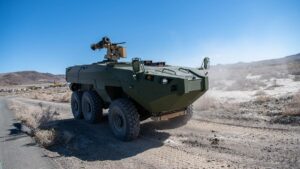The Marine Corps has detailed its plan for establishing new Mobile Reconnaissance Battalions (MRB), which will include the future Advanced Reconnaissance Vehicle (ARV) as part of a “family of systems.”
The latest annual update to the Marine Corps’ Force Design 2030 plan, published on Monday, sets a goal to begin the effort to transition from Light Armored Reconnaissance (LAR) battalions to MRBs by September, to include establishing a new program manager for mobile reconnaissance role to oversee capability efforts.

“Our wargames, modeling and simulation, experiments, and exercises, along with evidence from the Western Pacific to Ukraine confirm the requirement for littoral, multi-domain reconnaissance capabilities that our light armored reconnaissance battalions do not currently provide. Our Ground Combat Element, therefore, requires organizational and equipment changes to meet requirements for lighter, more expeditionary capabilities to operate as part of a stand-in force, and to contribute to all-domain reconnaissance,” the Marine Corps’ annual update states.
Lt. Gen. Karsten Heckl, deputy commandant for combat development and integration, told reporters ahead of the update’s release that the Marine Corps is about 70 percent of the way into figuring out its priorities for MRBs and cited the PM for Mobile Reconnaissance as key for organizing development efforts.
“[The PM for Mobile Reconnaissance] can kind of shepherd all those efforts and then bend them where they need to go as we work toward [doctrine and organizing],” Heckl said. “There’s a lot of things going on here. We don’t know exactly what the right answer is. We know we’re pointing in the right direction. And we think establishing a PM at [Marine Corps Systems Command] would be helpful.”
More specifically, the updates notes the new PM will be responsible for overseeing the “synchronized sun-down of the family of light armored vehicles, while simultaneously developing, integrating, and fielding new ground, surface, and aerial systems.”
The Marine Corps is currently pursuing a competitive ARV prototyping effort to help find a replacement for its legacy Light Armored Vehicles, and is currently evaluating a version of BAE Systems’ Amphibious Combat Vehicle (ACV) integrated with a suite of C4/UAS capabilities as well two competitive offerings from General Dynamics Land Systems [GD] and Textron Systems [TXT] as it charts a path forward for the effort (Defense Daily, April 3).
“We are in competition with three vendors and we will downselect based on what the operational need is for the fleet,” Heckl said. “We clearly identify there is a requirement for some type of LAV replacement. We know that for sure.”
Brig. Gen. Stephen Lightfoot, director of the Marine Corps’ Combat Development Directorate, reiterated the idea is to look at outfitting the new MRBs with a “family of systems,” rather than focusing on building them around a single platform, like ARVs.
“We’re looking at a combination of systems. We’re looking at ultralight vehicles. We’re looking at light vehicles. We’re looking at, potentially, light armored vehicles and that’s where the ARV comes in…As well as even [looking at] small boats,” Lightfoot told reporters. “We’ve got to have something that can do what we need it to do in whatever terrain, whether that’s air or ground or sea. We have to have something that’s capable of accomplishing that.”
Heckl added that each MRB will likely look different, with plans to tailor what capabilities are provided based on that specific organization’s operational requirements.
“My guess is that each [MRB] for each [Marine Expeditionary Force] is going to look different. My assessment is that a Mobile Reconnaissance Battalion that operates primarily in Northern Africa is going to have different requirements than an MRB that would operate within the first island chain. And that family of systems that we’re going to provide, we will tailor that to each specific MEF’s requirements. And, quite frankly, we will listen to MEF’s commanders and the [Marine Corps Forces] commanders are asking for and indicating that they have needs and requirements,” Heckl said.
Brig. Gen. Kyle Ellison, head of the Marine Corps Warfighting Lab, said the aim is to have an experimentation plan for the new MRB concept in place by October.
“We’re in the process right now, and have been quite frankly for the last several months, of putting that service-level experimentation plan together. It’s in the final stage of review,” Ellison said.